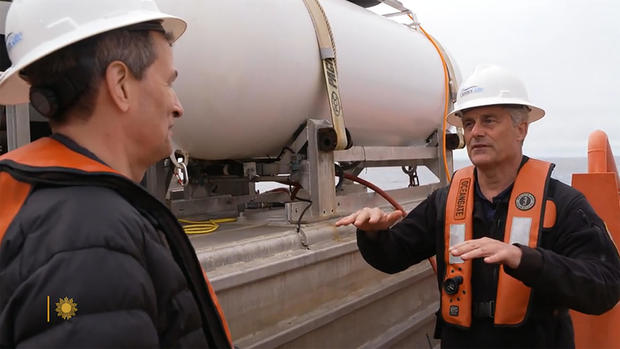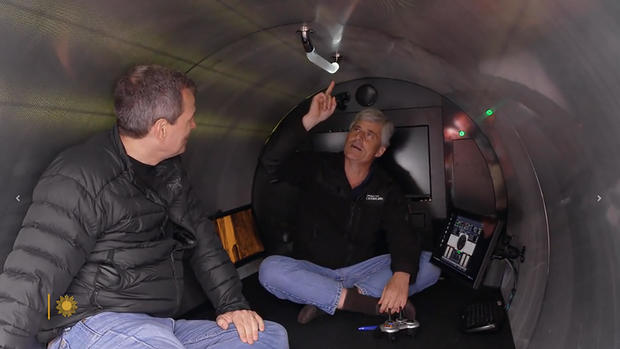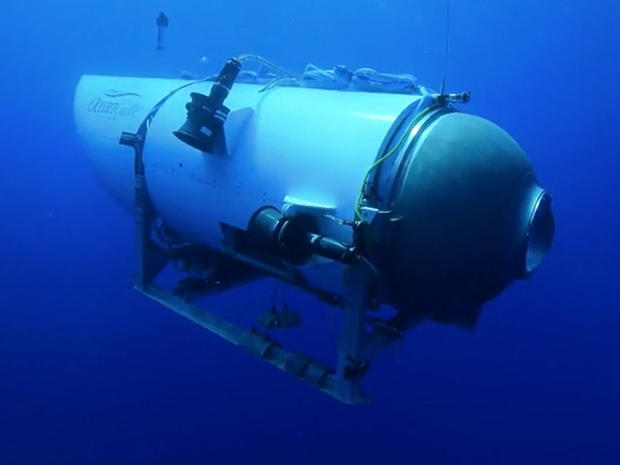A second Titanic tragedy: The failure of OceanGate's Titan
"Catastrophic implosion" – The unthinkable became all-too-real this past week as we learned of the fate of undersea explorer Stockton Rush's Titan submersible on its way to the Atlantic grave of the TItanic. The questions and the second-guessing, David Pogue tells us, are likely to continue for a long time to come:
Last summer, a company called OceanGate invited "Sunday Morning" to join an expedition to the Titanic. At the time, I was thrilled!
As the whole world knows now, OceanGate's business was taking adventure seekers on these Titanic dives for $250,000 a ticket, on a one-of-a-kind carbon fiber submersible called the Titan.
"Carbon fiber is a great material," said Stockton Rush: the CEO of OceanGate and designer of the sub. "It's better than titanium, it's better than a lot of other materials."
Last Sunday, as Rush was piloting the sub to the Titanic, it imploded, killing him and his four passengers.
We spent nine days at sea with Rush last summer. In light of the tragic news, we thought you might like to see more of what we saw, and hear more of what Stockton Rush said.
The Titan wasn't like any previous deep-sea submersible. There was no dashboard; just a touchscreen computer and a single power button.
Pogue said, "Wait a minute: I've seen submersibles, and there're banks of controls, like cockpit after cockpit?"
"Exactly," Rush said. "Yeah, this is to other submersibles what the iPhone was to the Blackberry."
But many of its components seemed surprisingly cheap. For views outside the sub, Rush had installed store-bought security cameras. Ceiling lights were bought from Camper World. And for his steering unit? "We run the whole thing with this game controller," he said.
"So, it seems like a lot of the way you made this is by taking off-the-shelf parts and sort of MacGyver-ing them together?" asked Pogue.
"Yeah. Pretty much."
"Does that not raise anybody's eyebrows in the industry?"
"Oh yeah, yeah," said Rush. "No, I'm definitely an outlier. There were a lot of rules out there that didn't make engineering sense to me."
Everyone I know keeps asking me the same question: "Why would you ever get on that dangerous sub?"
Well, first of all, Stockton Rush had the credentials: he majored in aerospace engineering at Princeton; he designed and flew his own airplanes; and he'd designed previous submersibles.
Second, he insisted that the important parts of the Titan were rock-solid, like the carbon-fiber body, for which NASA served as a consultant. "There are certain things that you want to be buttoned-down, and that's the pressure vessel," he said. "Once you're certain [the pressure vessel is] not gonna collapse on everybody, everything else can fail. Your thrusters can go, your lights can go. You're still gonna be safe."
Third, I was convinced by an expert: P.H. Nargeolet, the veteran deep-sea explorer who also perished in the Titan.
Over the years, he'd been to the Titanic more than just about anyone – 37 times, when we talked last summer. He was in charge of five different subs.
Pogue asked, "How different is the Titan from those other subs?"
"Oh, completely different," Nargeolet replied. "Most of them, you have a sphere."
"Was there never a point when you wondered about the safety of the sub at that depth?"
"No. Two, three years ago I have a phone call with Stockton, and he explained to me that he was doing a lot of tests. He showed me some [of] the ways they were building the stuff. I say, 'Okay, that's fine. That's fine. I have no problem diving this sub.'"
I was also impressed by the sub's seven redundant systems for returning to the surface, from roll weights, to hydraulically-driven triple weights, to thrusters, to a variable ballast tank that inflates from a 10,000-psi air tank. Then there are sandbags that detach automatically after about 16 hours. "Even if everyone inside had passed out, their connectors would dissolve in sea water," said expedition manager Kyle Bingham.
Pogue asked, "So, you have a backup of a backup of a backup of a backup of a backup?"
"Correct."
Finally, the crew seemed to foster a culture of safety. There were checklists, inspections before and after every dive, and a "three-strikes" rule. If three things seemed out of the ordinary, no matter how minor, they'd cancel the dive.
I learned that the hard way on our own dive. As divers were preparing to detach the sub from its launcher, floats came off the platform – that wasn't supposed to happen.
I never did see the Titanic, and I wasn't unusual. In OceanGate's first two summers of Titanic operations, it spent a total of 50 days floating above the shipwreck site, but because of waves, bad weather and malfunctions, the Titan submersible actually made it to the Titanic only 12 times.
But through it all, Stockton Rush defended his unconventional approach: "I mean, anything when you're trying something outside the box, people inside the box think you're nuts. Same thing when Elon Musk was doing SpaceX. Inside the box, everything's scary."
But as early as 2018, there was concern about the Titan's design. A former employee says that when he raised safety concerns, Rush fired him. That same year, a group of submersible engineers urged Rush to seek certification of the Titan by a safety agency. Rush declined, saying that regulation would stifle innovation.
- Years before Titanic sub went missing, OceanGate was warned about "catastrophic" safety issues
- OceanGate CEO Stockton Rush said in 2021 he'd "broken some rules" in design of Titan sub that imploded
Rush told Pogue, "You know, at some point, safety just is pure waste. I mean, if you just want to be safe, don't get out of bed, don't get in your car, don't do anything. At some point you're gonna take some risk, and it really is a risk/reward question. I said, 'I think I can do this just as safely by breaking the rules.'"
Retired U.S. Navy submarine captain Alfred McLaren, who calculates he has spent a little over five-and-three-quarters years under the water, is not impressed by OceanGate's innovations. "I mean, would you fly in an airplane that somebody excitedly tells you, 'Well, it's gonna be a lot cheaper 'cause we found a new way of attaching the wings'? Yeah, right!"
McLaren theorizes that the Titan failed not because it was made of carbon fiber, but because it was made of three dissimilar materials: carbon fiber, titanium, and Plexiglas for the porthole. "When you have different materials, different molecular structure, they have different coefficients of expansion and compression. And then you make repeated cycles in depth? Of course you're gonna work that seal loose. And that's why submarines don't run around with any portholes at all, come to think of it. It's a weak point."
In an interview this week with Anderson Cooper for CNN, filmmaker and veteran Titanic diver James Cameron pointed out a sad parallel between Stockton Rush and the captain of the Titanic.
"I think there's a great, almost surreal irony here, which is Titanic sank because the captain took it full-steam into an ice field at night on a moonless night with very poor visibility after he had been repeatedly warned by telegram," Cameron said. "The arrogance and the hubris that sent that ship to its doom is exactly the same thing that sent those people in that sub to their fate."
The world mourns the loss of Stockton Rush, P.H. Nargeolet, and their three passengers: British billionaire Hamish Harding, Pakistani businessman Shahzada Dawood, and his son, Suleman.
Already, there's talk of restrictions and regulations and lawsuits. Will the OceanGate disaster mean fewer people going adventuring?
Well, every year people do die skydiving, scuba diving, and climbing Mount Everest. Tragic every time, and yet, people keep coming. Some people just have that itch. For them, danger is the point. The risk of dying gives meaning to living.
I think Stockton Rush was among them.
"I wanted to be sort of the Captain Kirk," Rush said. "I didn't want to be the passenger in the back. And I realized that the ocean is the universe. That's where life is."
WEB EXCLUSIVE: Read extended interviews with OceanGate CEO Stockton Rush from 2022 talking Titan sub's design, carbon fiber hull, safety and more
Story produced by Anthony Laudato. Editor: George Pozderec.
See more:







